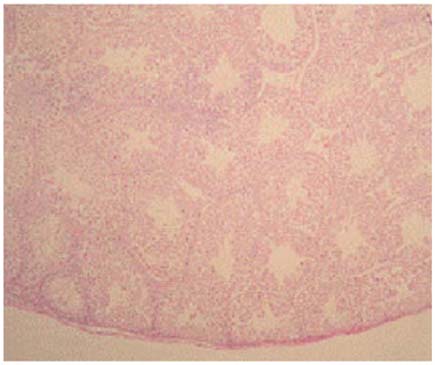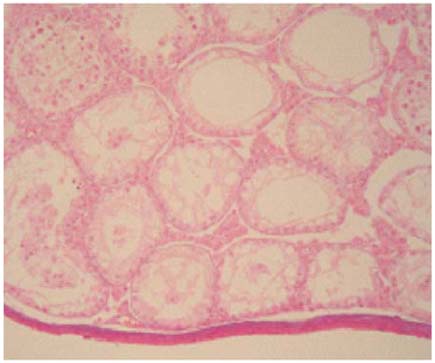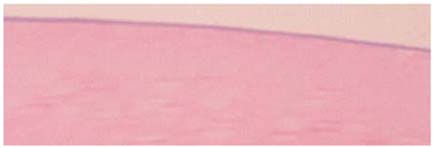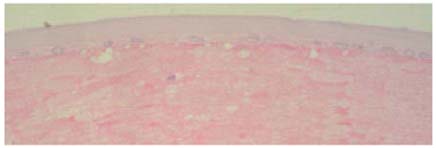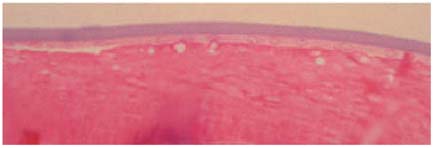J Vet Sci.
2006 Mar;7(1):19-23. 10.4142/jvs.2006.7.1.19.
Histopathological changes of testes and eyes by neutron irradiation with boron compounds in mice
- Affiliations
-
- 1College of Veterinary Medicine, Chungnam National University, Daejeon 305-764, Korea. swcho@cnu.ac.kr
- 2Korea Research Institute of Bioscience and Biotechnology, Daejeon 305-333, Korea.
- 3Korea Atomic Energy Research Institute, Daejeon 305-353, Korea.
- KMID: 1103548
- DOI: http://doi.org/10.4142/jvs.2006.7.1.19
Abstract
- This study was performed to investigate the biological effects of boron neutron capture therapy (BNCT) on the testes and eyes in mice using HANARO Nuclear Reactor, Korea Atomic Energy Research Institute. BNCT relies on the high capacity of (10)B in capturing thermal neutrons. Sodium borocaptate (BSH, 75 ppm, iv) and boronophenylalanine (BPA, 750 ppm, ip) have been used as the boron delivery agents. Mice were irradiated with neutron (flux: 1.036739E +09, Fluence 9.600200E+12) by lying flat pose for 30 (10 Gy) or 100 min (33 Gy) with or without boron carrier treatment. In 45 days of irradiation, histopathological changes of the testes and eyes were examined. Thirty-three Gy neutron irradiation for 100 min induced testicular atrophy in which some of seminiferous tubules showed complete depletion of spermatogenic germ cells. Lens epithelial cells and lens fiber were swollen and showed granular changes in an exposure time dependent manner. However, boron carrier treatment had no significant effect on the lesions. These results suggest that the examination of histopathological changes of lens and testis can be used as "biological dosimeters" for gauging radiation responses and the HANARO Nuclear Reactor has sufficient capacities for the BNCT.
Keyword
MeSH Terms
-
Animals
Boranes/*pharmacology
Borohydrides/*pharmacology
Boron Neutron Capture Therapy/*methods
Eye/pathology/*radiation effects
Histocytochemistry
Male
Mice
Mice, Inbred C57BL
Neutrons
Phenylalanine/*analogs&derivatives/pharmacology
Seminiferous Tubules/pathology/*radiation effects
Specific Pathogen-Free Organisms
Sulfhydryl Compounds/*pharmacology
Figure
Reference
-
1. Barth RF, Soloway AH, Fairchild RG. Boron neutron capture therapy of cancer. Cancer Res. 1990. 50:1061–1070.2. Barth RF, Soloway AH, Goodman JH, Gahbauer RA, Gupta N, Blue TE, Yang W, Tjarks W. Boron neutron capture therapy of brain tumors: an emerging therapeutic modality. Neurosurgery. 1999. 44:433–451.
Article3. Binns PJ, Riley KJ, Harling OK. Epithermal neutron beams for clinical studies of boron neutron capture therapy: a dosimetric comparison of seven beams. Radiat Res. 2005. 164:212–220.
Article4. Coderre JA, Elowitz EH, Chadha M, Bergland R, Capala J, Joel DD, Liu HB, Slatkin DN, Chanana AD. Boron neutron capture therapy for glioblastoma multiforme using p-boronophenyl alanine and epithermal neutrons: trial design and early clinical results. J Neurooncol. 1997. 33:141–152.5. Coderre JA, Morris GM. The radiation biology of boron neutron capture therapy. Radiat Res. 1999. 151:1–18.
Article6. Coderre JA, Turcotte JC, Riley KJ, Binns PJ, Harling OK, Kiger WS 3rd. Boron neutron capture therapy: cellular targeting of high linear energy transfer radiation. Technol Cancer Res Treat. 2003. 2:355–375.
Article7. Dagrosa MA, Viaggi M, Rebagliati RJ, Castillo VA, Batistoni D, Cabrini RL, Castiglia S, Juvenal GJ, Pisarev MA. Biodistribution of p-borophenylalanine (BPA) in dogs with spontaneous undifferentiated thyroid carcinoma (UTC). Appl Radiat Isot. 2004. 61:911–915.
Article8. Hatanaka H. Karim ABMF, Law ER, editors. Boron-neutron capture therapy for tumors. Glioma. 1991. Berlin: Springer-Verlag;233–249.
Article9. Hatanaka H, Nakagawa Y. Clinical results of long-surviving brain tumor patients who underwent boron neutron capture therapy. Int J Radiat Oncol Biol Phys. 1994. 28:1061–1066.
Article10. Hawthorne MF. New horizons for therapy based on the boron neutron capture reaction. Mol Med Today. 1998. 4:174–181.
Article11. Heine U, Klug H, Weber C, Eichhorn HJ, Welker K, Regel K. Ultrastructural retinal changes after irradiation with fast neutrons. Ophthalmic Res. 1987. 19:76–81.
Article12. Imahori Y, Ueda S, Ohmori Y, Yoshino E, Ono K, Kobayashi T, Takagaki M, Oda Y, Ido T, Mishima Y. Positron emission tomography and boron neutron capture therapy using bronophenylallanine for highgrade gliomas: Part II. Clin Cancer Res. 1998. 4:1833–1841.13. Kinashi Y, Masunaga S, Ono K. Mutagenic effect of borocaptate sodium and boronophenylalanine in neutron capture therapy. Int J Radiat Oncol Biol Phys. 2002. 54:562–567.
Article14. Matalka KZ, Barth RF, Bailey MQ, Wilkie DA, Koestner AD, Hopewell JW. Radiation effects of Boron neutron capture therapy on brain, skin, and eye of rats. Int J Radiat Oncol Biol Phys. 1994. 28:1089–1097.
Article15. Mishima Y, Honda C, Ichihashi M, Obara H, Hiratsuka J, Fukuda H, Karashima H, Kobayashi T, Kanda K, Yoshino K. Treatment of malignant melanoma by single thermal neutron capture therapy with melanoma seeking 10B-compound. Lancet. 1989. 2:388–389.16. Obayashi S, Kato I, Ono K, Masunaga S, Suzuki M, Nagata K, Sakurai Y, Yura Y. Delivery of (10)boron to oral squamous cell carcinoma using boronophenylalanine and borocaptate sodium for boron neutron capture therapy. Oral Oncol. 2004. 40:474–482.17. Soloway AH, Hatanaka H, Davis MA. Penetration of brain and brain tumor. VII. Tumor-binding sulfhydral boron compounds. J Med Chem. 1967. 10:714–717.
Article18. Son HY, Kim YB, Kang BH, Cho SW, Ha CS, Roh JK. Effects of 2-bromopropane on spermatogenesis in the Sprague-Dawley rat. Reprod Toxicol. 1999. 13:179–187.
Article19. Suzuki M, Masunaga SI, Kinashi Y, Takagaki M, Sakurai Y, Kobayashi T, Ono K. The effects of boron neutron capture therapy on liver tumors and normal hepatocytes in mice. Jpn J Cancer Res. 2000. 91:1058–1064.
Article20. van Beek ME, Davids JA, de Rooij DG. Variation in the sensitivity of the mouse spermatogonial stem cell population to fission neutron irradiation during the cycle of the seminiferous epithelium. Radiat Res. 1986. 108:282–295.
Article21. Yang W, Barth RF, Rotaru JH, Boesel CP, Wilkie DA, Bresnahan JC, Hadjiconstantinou M, Goettl VM, Joel DD, Nawrocky MM. Boron neutron capture therapy of brain tumors: functional and neuropathologic effects of blood-brain barrier disruption and intracarotid injection of sodium borocaptate and boronophenylalanine. J Neurooncol. 2000. 48:179–190.22. Leśnikowski ZJ, Paradowska E, Olejniczak AB, Studzinska M, Seekamp P, Schubler U, Gabel D, Schinazi RF, Plesek J. Towards new boron carriers for boron neutron capture therapy: metallacarboranes and their nucleoside conjugates. Bioorg Med Chem. 2005. 13:4168–4417.
Article
- Full Text Links
- Actions
-
Cited
- CITED
-
- Close
- Share
- Similar articles
-
- Preliminary Study for Dosimetry of Boron Neutron Capture Therapy with Polymer Gel
- Boron delivery systems for enhanced boron neutron capture therapy: a comprehensive review
- Monitoring Tumor Size Using PET with a Collimator during Boron Neutron Capture Therapy: Simulation Study
- Assembly Neutron Moderation System for BNCT Based on a ²âµÂ²Cf Neutron Source
- Preliminary Study for Imaging of Therapy Region from Boron Neutron Capture Therapy

